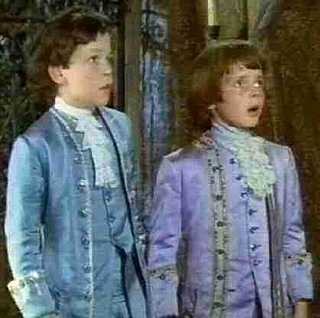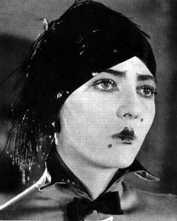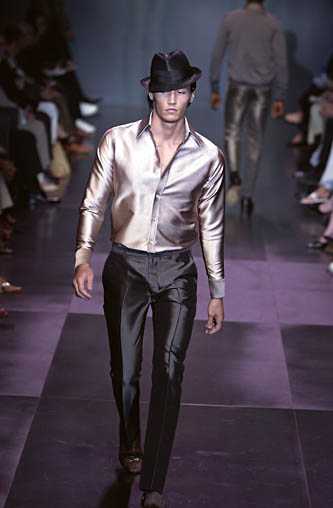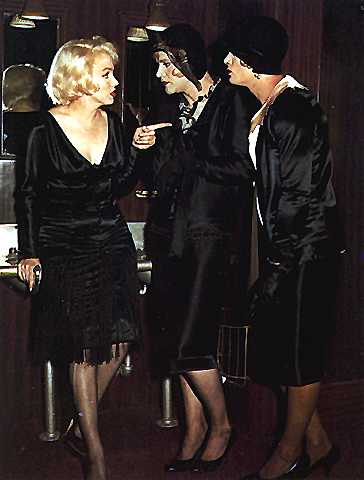 |
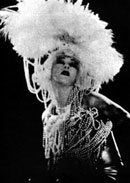 |
|
Galleries
|
|
| forbidden fashion | links | email | |
| laced tight | heeled and gloved | the peacock's tail | glamourised | wonder woman | |
The Peacock's Tail |
 |
|
If you were able to time-travel back in to the 17th and 18th centuries in the British colonies in America, many aspects of people's dress would probably surprise you. One of the big surprises would be that men's clothes were every bit as fancy and as fussy as women's clothes.
|
Women were no more likely than men to wear bright colors, fancy buttons and buckles, wigs, embroidery, or ruffles. Men who could afford it and who were free from the dirt and sweat of physical labor wore satin or velvet waistcoats richly decorated with embroidery or brocade; the waistcoats might be fastened with buttons made of gold, silver, and precious stones. Above the waistcoat they might wear a ruffled linen collar decorated with lace. In the late 1600's, gentlemen also began wearing tightly curled, powdered wigs. |
|
Should men wear glamorous clothing?
|
|
|
What about our male friends in Niger, the Wodaabe, who spend hours applying make-up and heavy jewelry in order to compete for womanly affections? Those yards and yards of cowrie shells and feathered headdresses can't be very easy to walk in. Or, since we're speaking of shoes, what about the ridiculous, two-foot-long poulaines that men wore during the 14th century? (Poulaines, which Robinson calls "phallic-shaped," were shoes with long, pointed toes that curled at the end. The points ranged from six inches for a commoner up to two feet for a prince.)
Or what about the 12-inch geta that Japanese Emperor Hirohito wore for his 1926 coronation?
First to wear High Heels, Silk Stockings and "Foundations"? Men, of course.In 1558 Henry II wore silk stockings to his sister's wedding in England, starting the silk stocking fad in that country. High Heels were inspired by Louis XIII of France. The first ones were red and elevated by him to the "uncomfortable height of three inches". Louis XVI put jewels into his high heels. Corsets with curved steel rods encased first men, then women, about the 16th century. The stiffened bodice came into fashion during the Elizabethan period. Stuffed hips, achieved by padding the colorful doublets worn by men, came into vogue after the age of chivalry and Sir Walter Raleigh began. Men were the leaders during the lace and ruffles period. They wore shirts with ruffles, sleeves with lace cuffs and carried perfumed handkerchiefs. But it was during the French Revolution that simpleness in clothes replaced the elaborate designs. |
|
We have been toldthat the male is more courageous, more aggressive, more adventurous, more individualistic, more creative, more ready to take the initiative. The female we think of as the more timid, the more regimented, etc. Amram Scheinfeld "Another French industry that was almost destroyed by the Revolution was that of lace-making. Thirty factories closed and many of the lace-makers emigrated, chiefly to Belgium. After Napoleon became emperor of France he tried to revive the use of lace, for the sake of the lace industry. Court dress in France became more formal again. ... Gentlemen were required to wear lace frills at their wrists and lace ends to their cravats. Ladies sometimes wore court dresses made entirely of lace. But the old enthusiasm for it was dead." Agnes Allen "The immediate effects of the French Revolution in 1789 were to make the wearing of fine clothing a dangerous thing. The nobility and wealthy classes ... were looked upon by the mobs of Paris as the enemies of society, and there was no hesitation in tearing them to pieces or sending them to the guillotine. ... Those who stayed disguised themselves by wearing the simplest and poorest clothing for a period of several years." Paul H. Nystrom
"The political organization ... of the Tuareg was hierarchical. ... A major distinction of the nobility was that its menfolk were veiled, never revealing their faces below the eyes." Richard Oliver and J. D. Fage |
|
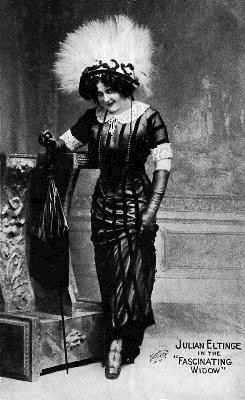 |
 |
|
The present "feminization" of the masculine image, which is present not only in the most seducing and luxurious garments, but also in the frivolous styling used on the catwalks, is not something new. Western society has already witnessed this phenomenon at other times. During the Old Regimen, before the French Revolution, men wore as many colors, ornaments and embroidery as women, even surpassing them at certain times. The kingdom of Louis XIV brought with it a true paroxysm of male ornamentation. The man in the court of that time used make-up, wore wigs and embroidery-covered garments, as well as bows and gems in the full spectrum of colors. After the bourgeois revolutions, this situation changed and the sexual roles that have defined customs until now were created. |
|
|
|
|
|
|
|
